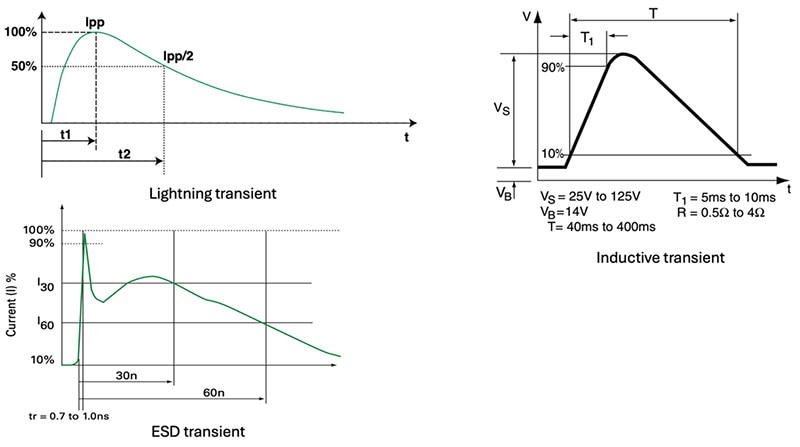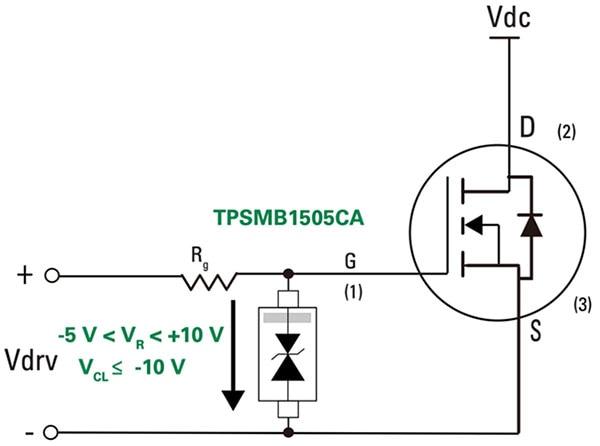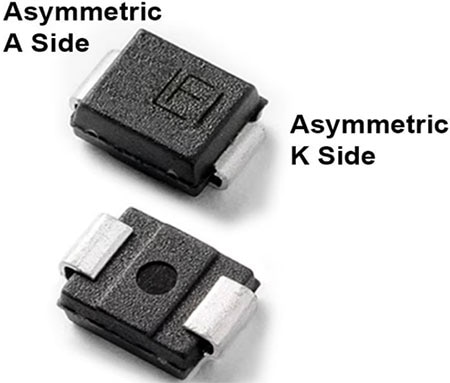Use Asymmetric TVS Diodes to Protect Critical Circuits from Destructive Voltage Transients
Transient voltage spikes or surges impact electronic circuits in various ways, from annoying to catastrophic. These transients can originate from sources such as lightning and electrostatic or inductive discharge (Figure 1).
 Figure 1 : Transients can occur from sources such as lightning and electrostatic or inductive discharge and wreak havoc with unprotected electronics. (Image source Littelfuse Inc.)
Figure 1 : Transients can occur from sources such as lightning and electrostatic or inductive discharge and wreak havoc with unprotected electronics. (Image source Littelfuse Inc.)
Transients like these can generate pulses with peak voltages from hundreds to tens of thousands of volts, currents in the kiloamp range, and time durations from hundreds of nanoseconds to milliseconds.
The miniaturization of ICs and processors and reduced supply voltages have increased the sensitivity to electrical transients. This is particularly true of vehicles where multiple electronic systems control everything, including the engine, steering, braking, climate, and entertainment.
Several design strategies have been developed to protect sensitive circuits, including shielded wiring, filters, crowbars, and clamping devices. Shielding and filtering use passive designs, while crowbars and clamping protection use active mechanisms. Crowbar devices like spark gaps, gas discharge tubes, and thyristors shunt transients to ground to protect circuits. The protected device does not function while the crowbar is active, but is operational once the transient subsides.
Clamping devices include metal oxide varistors (MOVs), Zener diodes, and transient voltage suppression (TVS) avalanche diodes that maintain a constant voltage across the protected device by varying their impedance. These techniques can be used either singly or concurrently. TVS diodes are widely favored as clamping devices due to their fast response times and high power dissipation.
Transient voltage suppression diodes
The TVS diode is an avalanche diode that acts as a clamping device that shunts excess current when the applied voltage exceeds its avalanche breakdown voltage, holding or clamping the voltage at a constant potential. It automatically resets when the applied voltage falls below the breakdown value.
TVS diodes are available as unidirectional devices that protect against transients of a single polarity and bidirectional devices that protect against transients of either polarity (Figure 2). The bidirectional components can be symmetrical, clamping the same voltage amplitude of either polarity or asymmetrical, clamping to different voltage levels depending on the transient’s polarity.
 Figure 2 : Shown are the current-voltage breakdown characteristics of the three types of TVS devices and their schematic symbols. (Image source Littelfuse Inc.)
Figure 2 : Shown are the current-voltage breakdown characteristics of the three types of TVS devices and their schematic symbols. (Image source Littelfuse Inc.)
The unidirectional TVS diode operates like a simple diode, conducting when forward-biased and not conducting when reverse-biased until the diode's breakdown voltage (VBR) is exceeded. When the applied voltage exceeds VBR, the diode conducts, holding the voltage across it at the clamping voltage (VC). The diode can dissipate a maximum power of peak pulse current (IPP) x VC.
The bidirectional TVS diode acts as two diodes back to back. A small reverse leakage current (IR) flows until the breakdown voltage (VBR) is exceeded in either direction. The operation is symmetrical as the breakdown voltage magnitude in either bias condition is the same.
The asymmetric TVS diode acts like the bidirectional device, except the breakdown voltages (VBR1 and VBR2) differ.
The asymmetric TVS diode
You might wonder why the asymmetric TVS diode is needed. These components were designed to protect the gate drivers on silicon carbide (SiC) MOSFETs. Due to the SiC switches' fast speed, these drivers are prone to damage from overvoltage transients. Consider a SiC MOSFET for onboard charging or a traction inverter (Figure 3).
 Figure 3 : Shown is the asymmetric TPSMB1505CA TVS protecting the gate driver of a SiC MOSFET switch. (Image source: Littelfuse Inc.)
Figure 3 : Shown is the asymmetric TPSMB1505CA TVS protecting the gate driver of a SiC MOSFET switch. (Image source: Littelfuse Inc.)
The asymmetric Littelfuse TPSMB1505CA TVS is used to protect the gate driver of the MOSFET. The gate driver has two states; the on state has a gate voltage between -5 and +10 volts, while the off state drives the gate to less than -10 volts. The TPSMB1505CA has a rated cathode (K) to anode (A) breakdown voltage of 16.7 to 18.5 volts with a maximum clamp voltage of 24.4 volts. The Ipp in this direction is 24.6 amperes (A) for a transient pulse duration between 10 and 1000 microseconds (ms).
The A to K breakdown voltage for the TVS is 6.8 to 7.4 volts, with a maximum clamp voltage of 11.5 volts. The peak pulse current in this direction is 60 A for the same 10 to 1000 ms transient pulse duration. Note that this is done with a single component. It would take multiple components to achieve this asymmetrical operation with individual devices.
The Littelfuse TPSMB Asymmetric Series TVS Diodes (Figure 4) include two additional components that differ in their K to A breakdown voltages. The TPSMB1805CA offers a K to A breakdown voltage range of 20.0 to 21.1 volts with a maximum clamp voltage of 29.2 volts. The Ipp rating is 20.6 A for a pulse duration of 10 to 1000 ms. The A to K breakdown range is the same as the TPSMB1505CA (6.8 to 7.4 volts).
 Figure 4: The TPSMB asymmetric devices come in a surface mount DO-214AA package with an incised bar designating the K side of the device. (Image source: Littelfuse Inc.)
Figure 4: The TPSMB asymmetric devices come in a surface mount DO-214AA package with an incised bar designating the K side of the device. (Image source: Littelfuse Inc.)
The TPSMB2005CA has a K to A breakdown voltage range of 22.2 to 24.5 volts and a maximum clamp voltage of 32.4 volts. The Ipp rating is 18.6 A for the same pulse duration as the other diodes. The A to K breakdown range is the same as the TPSMB1505CA.
All three TVS diodes are rated at 600 watts peak pulse power for waveform durations of 10 to 1000 ms, and all are automotive AEC-Q101 qualified. They are packaged in a DO-214AA surface mount package to optimize board space and allow the diodes to be placed close to the circuit contacts for the best possible protection. An incised bar on the package indicates the K side of the device.
Conclusion
The TPSMB symmetric and TPSMB asymmetric TVS series are ideal for protecting sensitive electronic circuits from voltage transients caused by lightning and electrostatic or inductive discharge. The TPSMB asymmetric devices are particularly well-suited to protecting the gate drivers of fast SiC switches where a single TVS component covers both turn-on and turn-off drive levels.

Have questions or comments? Continue the conversation on TechForum, Digi-Key's online community and technical resource.
Visit TechForum








